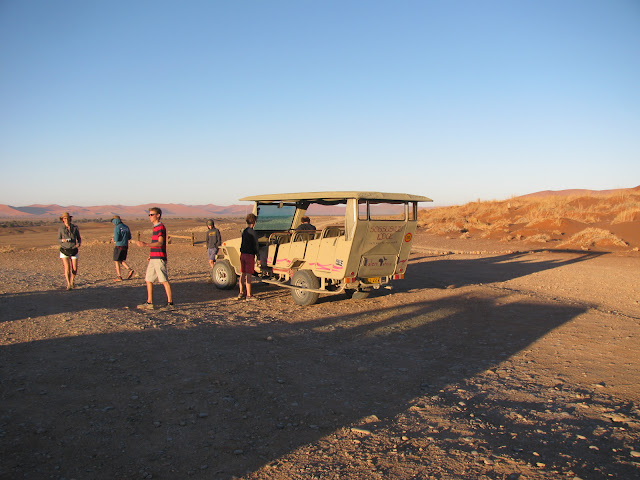Bruce had the week off from school and work so that can only mean one thing--road trip. This time we decided to head south to visit the number one tourist attraction in Namibia, Sossusvlei and the Namib-Naukluft Park. This is desert country and one of the world's largest national parks. The Namib-Naukluft Park takes in around 23,000 sq km of arid and semi-arid land.
We began the four day trip by crossing the Naukluft mountains in central Namibia following the seasonal (usually dry) Tsauchab river. The roads are gravel and except for several wash out places, were not too bad. The speed limit is 80km but we have found that a bit unrealistic and we end up going significantly slower. While the mountains are home to zebra, kudu, leopards, and other animals, we did not see many. However, we did pass a zebra carcass, but unfortunately no vultures were circling. I always picture Africa with circling buzzards and vultures, but we have yet to see any.
The landscape became progressively dry as we approached our first destination, Sesriem. Sesriem, according to Lonely Planet, means six thongs, which is the number of joined leather ox-wagon thongs necessary to draw water from the bottom the the gorge. Today the town is mainly a campground, petrol station, and a few lodges. It is also the gateway to Sossusvlei. We spent the night at the Desert Quiver Camp.


Sossusvlei is a large pan set amid sand dunes that tower up to 200 m. The road is in a flat area with dunes on both sides. There are several dunes that you are allowed to climb. The most famous is dune 45 which is about 150 m. high. This is the most photographed spot in Namibia.
You can notice the different colors of sand and people climbing up the ridge. The red sand originates in the Kalahari desert on the east side of Namibia. It is washed down the Orange River and out to sea, where it is deposited along the coast. The iron rich sand is lighter than the tan sand of the Namib desert. The lighter colored sand fills in between the red dunes and piles near the bottom of the dunes. There are also patches of black sand where the iron deposits have gathered. It is really quite surreal.
Sossusvlei is the pan at the end of the Tsauehab River flow. It rarely contains any water, but if the river gathers up enough volume, maybe every ten to fifteen years, the Sossusvlie is the farthest the water can travel. This pan is surrounded by dunes and any water is trapped there. Lime is leached out of the soil and creates a hard white crust on the floor on the pan.
Years ago the river changed its path It used to flow into what is now called the Dead Vlei. When the river course changed, the trees in the pan died. The resulting landscape is quite lovely, with dark dead trees, white lime pan floor and the red dunes surrounding it.


Of course you have to hike up and over the sand dunes to get the the Dead Vlei. My thighs are still a bit sore from the experience. Here are the tracks we made coming down. That was more fun than climbing up, but still a workout since your feet sink into the soft sand.

After the hike, we were more than ready for breakfast which was provided by our guide.
We ate under the shade of a thorn tree.
You might think that animals do not survive here. But there was a surprising amount of Onyx as well as springbok. I can't remember what kind of lizard this is. We also saw hyena, wild dog and desert mouse tracks. Our guide laughed at me when I asked about one track that I could not figure out. Turns out it was a man with a walking stick. I guess I am just naturally talented at tracking man!



















No comments:
Post a Comment